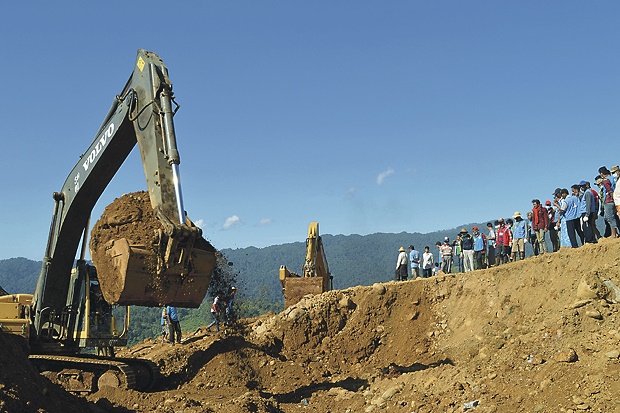
In this photo released from Eleven Media Group taken on Nov. 22, 2015, excavators dig dump soil to search bodies of miners as workers and rescue members gather in Hpakant, Kachin State, Myanmar. Soldiers, police and volunteers pulled body after body from the rubble in northern Myanmar on Monday, Nov. 23, 2015, as the death toll continued to rise from a landslide near several jade mines with many more missing. Eleven Media Group via AP
YANGON, Myanmar—Search teams Tuesday said they had given up hope of finding survivors from a landslide in north Myanmar’s jade mining heartland as they scoured for bodies from a disaster that left more than 100 dead.
READ: Landslide in Myanmar kills about 100; many others missing
It is one of the deadliest incidents to hit Hpakant in war-torn Kachin state, the hub of a billion-dollar jade trade that enriches a shadowy elite while destroying the local environment and social structure.
Scores of mainly itinerant prospectors were buried as they slept in makeshift tents when a towering mound of waste earth dumped by mining firms suddenly collapsed early Saturday morning.
Recovery teams including the army, police and local community organizations have pulled 113 bodies from the rubble. Only one man was found alive on Saturday, but died soon after of his injuries.
Dashi Naw Lawn of the Kachin Network Development Foundation, which is helping the search efforts, said no further survivors were expected.
“We are seeing only dead people,” he told AFP, adding that recovery operations continued at the site Tuesday with potentially dozens of people still missing.
Authorities could not confirm the number of people who were searching for jade at the time of the landslide.
But the state-backed Global New Light of Myanmar Tuesday quoted local officials as estimating another 30 bodies could still be buried.
It said the area had been designated “high risk” by authorities, who now plan to relocate a further 70 miner huts that have been built in the shadow of other waste mountains.
‘Stone of heaven’
Myanmar is the world’s primary source of the finest jadeite, a near-translucent green stone that is highly sought after in neighbouring China, where demand is surging as incomes rise.
The highest quality Myanmar jade is known by its Chinese admirers as “stone of heaven” or “imperial jade” because it was historically a preserve of the elite and is thought to possess a wealth of virtuous properties, including bringing its owner good health.
Jade values depend on the quality and craftsmanship of each individual piece, with raw chunks of the precious stone imported to China and Hong Kong where they are carved into jewellery and trinkets that can fetch anything between a few dollars to hundreds of thousands.
Mining firms linked to former junta figures, the military elite and cronies are thought to be raking in huge profits from the trade, which has dramatically expanded in recent years despite reforms under a new quasi-civilian regime.
Advocacy group Global Witness estimates the jade industry was worth some $31 billion in 2014 alone—a sum far exceeding the $3.4 billion official sales as most of the best quality jade is thought to be smuggled directly into China.
The area, once thickly covered in forest, is now ringed with naked hills and pocked with huge craters as large scale mining transforms the landscape.
Access to Hpakant is barred to nearly all foreigners, while the road into the area is an almost impassable mud track lined with army checkpoints and the huge orange trucks of the jade firms.
But it is a magnet to impoverished migrants from across Myanmar who flock to the area in the hope that they will strike rich.